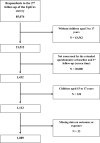High screen time and internalizing and externalizing behaviours among children aged 3 to 14 years during the COVID-19 pandemic in France
- PMID: 37268845
- PMCID: PMC10238248
- DOI: 10.1007/s00787-023-02241-5
High screen time and internalizing and externalizing behaviours among children aged 3 to 14 years during the COVID-19 pandemic in France
Abstract
Children's screen time increased as a result of the COVID-19 pandemic. In the summer of 2021, we explored the association between high screen time over a period of one year since May 2020 and behavioural problems among children and adolescents. The data were derived from the French EpiCov cohort study, collected in spring 2020, autumn 2020, and spring 2021. Participants (N = 1089) responded to online or telephone interviews about one of their children aged 3 to 14 years. Screen time was categorized as high if the daily mean screen time exceeded recommendations at each collection time. The Strengths and Difficulties Questionnaire (SDQ) was completed by parents to identify internalizing (emotional or peer problems) and externalizing (conduct problems or hyperactivity/inattention) behaviours in their children. Among the 1,089 children, 561 (51.5%) were girls, the average age was 8.6 years (SD 3.7). Internalizing behaviours: High screen time was not associated with internalizing behaviours (OR [95% CI] 1.20 [0.90-1.59]) or emotional symptoms (1.00 [0.71-1.41]) while it was associated with peer problems (1.42 [1.04-1.95]). Externalizing behaviours: High screen time was associated with externalizing problems (1.63 [1.01-2.63]) and conduct problems (1.91 [1.15-3.22]) only among older children aged 11 to 14 years. No association with hyperactivity/inattention was found. In a French cohort, exploration of persistent high screen time in the first year of the pandemic and behaviour difficulties in Summer 2021 resulted in mixed findings according to behaviour's type and children's age. These mixed findings warrant further investigation into screen type and leisure/school screen use to enhance future pandemic responses appropriate for children.
Keywords: COVID-19; Cohort study; Externalizing problems; Internalizing problems; Screen time.
© 2023. The Author(s), under exclusive licence to Springer-Verlag GmbH Germany.
Conflict of interest statement
The authors declare that they have no conflicts of interest.
Figures
References
MeSH terms
Grants and funding
LinkOut - more resources
Full Text Sources
Medical



